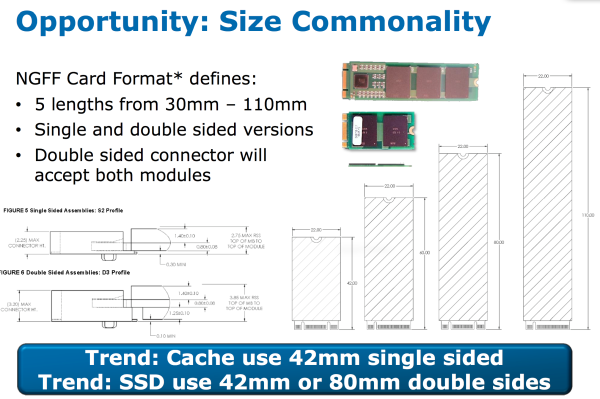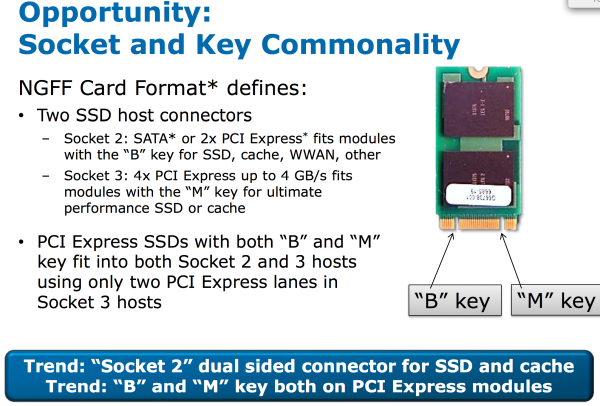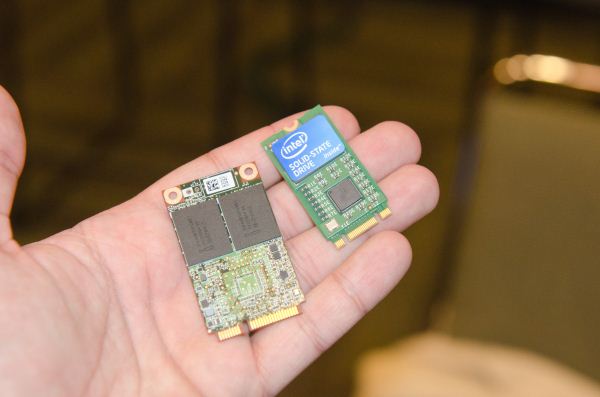NGFF SSDs: Putting an End to Proprietary Ultrabook SSD Form Factors
by Anand Lal Shimpi on September 13, 2012 2:32 PM ESTWe've seen a bunch of custom SSD form factors with the arrival of Ultrabooks as well as systems like the MacBook Air and Retina MacBook Pro. The need is simple: standard 7mm or 9.5mm SSDs are too big for some of these machines, and you don't actually need all of that volume to build a fast drive. mSATA cards work as a small form factor solution but they are only available in a single size. We need flexibility both on length (to allow for higher capacities) as well as on the interface side to enable higher performance. The NGFF specification gives us just that.
The spec allows for SATA, PCIe x2 or PCIe x4 interfaces. It also includes definitions for five different card lengths.
The proposed spec includes two connector definitions: Socket 2 and Socket 3. Socket 2 allows for SATA or PCIe x2 interface for SSDs, WWAN or other non-storage devices. Socket 3 is strictly for high-performance storage, offering up to 4GB/s of bandwidth in a tiny little package.
This is super exciting as far as I'm concerned. We've strayed too far from standardization and upgradability in the pursuit of ultimate mobility. Now all we need is a smaller form factor user replaceable memory standard.
Update: I just got some hands on shots with a few NGFF samples:
mSATA on the left, NGFF on the right



















41 Comments
View All Comments
KitsuneKnight - Thursday, September 13, 2012 - link
It's good to see progress being made on this front. With any luck, Apple will throw their weight behind this effort, and basically the entire industry will be able to standardize around a common high speed, tiny interface. Proprietary interfaces are only really acceptable when there's a need to get something out there immediately, and no standardize interface can accomplish the needs... but long term, the goal should be to try to adopt and champion standard interfaces.danjw - Thursday, September 13, 2012 - link
Apple go along with an industry standard that they didn't start? When has that happened in recent memory?erikwpotter - Thursday, September 13, 2012 - link
Recently? How about yesterday. They announced a fairly well known device that supported a couple of non-Apple standards. Off the cuff you can find they "went along" with...GSM
UMTS
HSPA+
DC-HSDPA
CDMA EV-DO Rev. A
CDMA EV-DO Rev. B
LTE
802.11a/b/g/n Wi-Fi (and a number of other 802.? standards)
Bluetooth 4.0
3.5mm stereo headphone jack
USB
AAC
HE-AAC
MP3
MP3 VBR
Audible/Audible Enhanced Audio/AAX/AAX+
WAV
H.264
.m4v
.mp4
MPEG-4
Motion JPEG
ulaw
.avi
.jpg
.tiff
.gif (images)
.doc and .docx
.htm and .html
.pdf
.ppt and .pptx
.txt
.rtf
.vcf
.xls and .xlsx
a ridiculous number of standards related to IP communications
50Hz
60Hz
120V
240V
a number of power plug standards
Composite AV
VGA
DVI
HDMI
DisplayPort
...
You can find a couple of Apple proprietary systems though...
The Lightning dock connector...that connects to USB for data and power charging...and has an adapter for compatibility with the dock used on all previous iPhones.
FairPlay, unlike Microsoft when they abandoned the people that bought music with their PlaysForSure DRM.
lowlymarine - Thursday, September 13, 2012 - link
While we're being pedantic, a huge number of those aren't "standards" as defined by the International Organization for Standardization. The old MS proprietary office formats, for example, or a variety of proprietary, patent-encumbered media formats (.gif, MP3, AAC, H.264). Also, Apple very explicitly DIDN'T support normal DisplayPort, foisting their own MiniDP design on us instead (not that that has anything to do with the iPhone anyways). Similarly, I must have missed the USB port on the new iPhone, and the VGA, DVI, HDMI, Composite AV ports as well. Unless you're referring to their PROPRIETARY dock connector for which they will gladly sell you very expensive adapters for (some of) those standards?Guspaz - Thursday, September 13, 2012 - link
Widely adopted, logical, rational standards are not evil just because Apple originated them, especially when they offer it royalty-free and push to get it part of the standard (it's now part of DisplayPort 1.2, since early 2009). They needed a small modern connector format and nothing out there already fit the bill (mini HDMI was probably the only other possibility and it has a rather delicate connector), so they came up with a new one. Clearly there was a need there, because you can currently find it on laptops and videocards from most major vendors, and you'll eventually find it in all laptops and desktops once Thunderbolt gets integrated into platform chipsets...yankeeDDL - Friday, September 14, 2012 - link
Give me a break: the connector does what a normal micro USB does. It is a deliberate choice to make yet another standard connector.darwiniandude - Saturday, September 15, 2012 - link
Micro USB does not allow for a cheap adaptor to make use of all the existing 30 pin dock connector equipment out there. That would have really angered people, not being able to upgrade their phone and keep the same docking speaker or car system.Micro USB is very very fragile. The 30 pin dock connector, is also fragile.
I've seen so many people break 30 pin connectors and Apple has to replace the device, it costs them money.
danjw - Thursday, June 13, 2013 - link
And USB was around when Apple created the 30 pin adapter.Bleakwise - Friday, February 12, 2016 - link
Sure it does. You just told us Apple sells one.Bleakwise - Friday, February 12, 2016 - link
I mean, you can plug your Apple 30 pin into into a USB port, and USB and Micro USB are 100% compatible. I'm not sure what language you chose for the words "does not allow" but in English that is by extension of the fact I just laid on you completely incorrect.